Did you know that 57.2 million Americans aged 16 and older feed wild birds around their homes each year? They spend about $4 billion on bird food in the U.S. every year1. Backyard birding is a fun way to enjoy nature. But, it’s easy to make mistakes that can ruin the fun. Knowing these common errors can make birdwatching better and more fun.
Ever locked your keys in the car while birding? It can cause big delays and cost a lot. Like the time in Lake Balmorhea, Texas, when it took over two hours and a lot of money to fix2. Always have a paper map just in case, because cell service isn’t always reliable. People who’ve lost service, like in Mississippi, know a DeLorme atlas is very helpful2. Make sure your tripod is stable to avoid damaging your gear2.
Don’t forget essentials like memory cards for your camera. You wouldn’t want to miss a photo of a Prairie Falcon near the Virginia/D.C. border2. Make sure you take care of personal needs before you start birdwatching. This is especially important in remote areas2. Birdwatching is great for beginners if they pay attention to these details.
Being safe while birdwatching is key. Don’t just worry about car keys. Make sure you have a backup plan and clean gear. Remember your personal needs too2. Dr. J. Drew Lanham believes birdwatching should be for everyone. Paying attention to small details can make a big difference in enjoying birdwatching.
List of the 12 backyard birding mistakes to avoid:
- Choosing the Wrong Type of Bird Feeders
- Using Inappropriate Bird Seed
- Neglecting Feeder Maintenance
- Forgetting to Provide Fresh Water Sources
- Ignoring Squirrel and Rodent Problems
- Not Changing Hummingbird Nectar Frequently
- Providing Moldy or Stale Bird Seed
- Not Configuring Your Yard to Attract Birds
- Locking Keys in the Car While Birding
- Not Having a Backup Plan Like a Paper Map
- Not Securing Gear Like Tripods Properly
- Forgetting Essentials Like Memory Cards and Toilet Paper
Key Takeaways
- Backyard birding is a popular activity among millions of Americans each year.
- Simple mistakes, like locking keys in the car, can lead to significant delays and expenses.2
- Always carry essential items like a paper map, memory cards, and toilet paper to avoid common issues.2
- Ensuring equipment is secure can prevent costly accidents.2
- Preparation ensures a more enjoyable and seamless birdwatching experience.
Choosing the Wrong Type of Bird Feeders
It’s vital to pick the right bird feeders for successful birdwatching in your backyard. The feeder type impacts which birds visit and their health. Let’s explore different feeders, benefits, and what mistakes to dodge.
Hopper or House Feeders
Hopper feeders need a lot of care. It’s best to clean them every month. But, if it’s wet or snowy, clean them weekly to stop mold3. Change the seed every 5-7 days to keep it fresh4.
Keeping food and water out all year is key for seeing many kinds of birds4.
Suet Feeders
Suet feeders draw woodpeckers and nuthatches. Clean them with hot soap water every week to fight bacteria and mold3. Birds like nearby natural shelters for protection4.
Finch Feeders
Finch feeders work best with fresh thistle seed. Clean these feeders weekly with a 9:1 water to bleach mixture4. This keeps the birds healthy and cuts down on seed mess3.
To make birdwatching great, keep all feeders clean and well-maintained. This avoids common feeding errors and keeps our bird friends healthy and joyful.
Using Inappropriate Bird Seed
Using the wrong bird seed can harm bird nutrition. It might also keep some birds away from your yard. It’s key to choose the best seed types to attract desired species.
Seed Types Birds Prefer
Birds like different seeds. For instance, cardinals, sparrows, and doves love safflower seeds. Finches prefer thistle seeds. With over 40 percent of Americans feeding birds, knowing their seed preferences is good for birdwatching5.
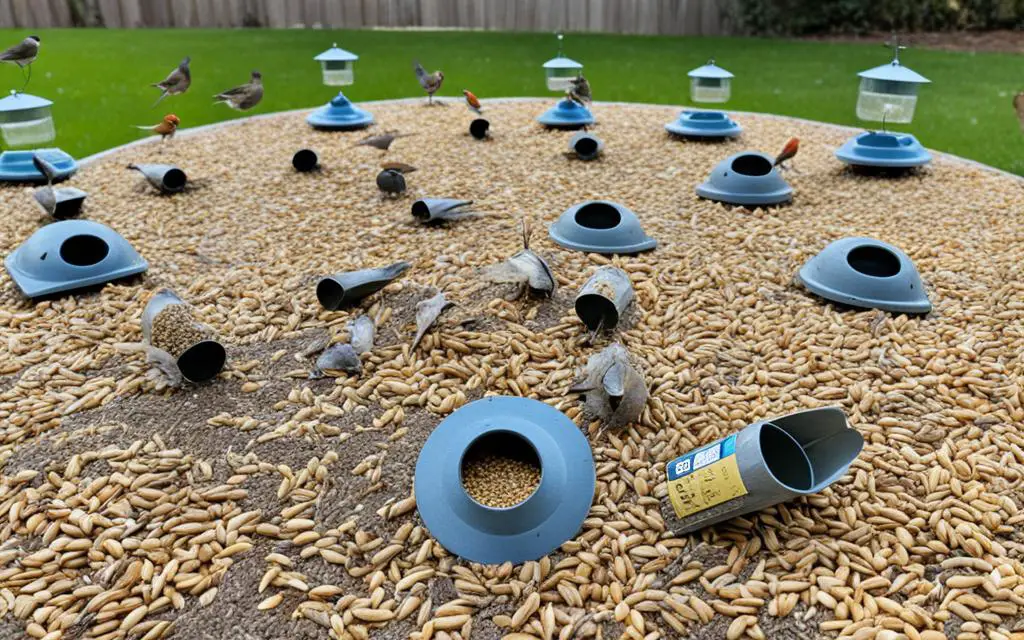
Avoiding Seed Waste
To prevent seed waste, pick the right bird seed blends. Many mixes have fillers like milo that birds don’t eat. This can create a mess and make birds sick under feeders5. By choosing seeds carefully for each feeder, we can lessen waste and keep different bird species from fighting over food5. Pick seeds that local birds like to see more of them and less waste.
In 2020, during the early COVID-19 pandemic, more people started feeding birds. This makes picking the right seed blends even more crucial6. Some birds are moving north because of feeders. Using the right seeds supports their new migration habits6.
By picking suitable seeds and avoiding mistakes, we boost bird health. This makes feeding birds in our backyards fun and useful.
Neglecting Feeder Maintenance
Keeping feeders clean and well-maintained is key for healthy, happy birds. This keeps the birds coming back. It also stops diseases from spreading.
Cleaning Your Feeders Regularly
Cleaning your feeders often is a top tip. Use soapy water and a bit of bleach to clean. This fights off bacteria that could harm the birds7. Clean feeders mean safe birds and happy watchers by cutting disease risks8.
Checking for Mold or Wet Seed
It’s important to look out for moldy or wet seeds. These can turn up especially after it rains. Moldy seeds can make birds sick or keep them away. Make sure to clean and swap out bad seeds to keep birds visiting7. Good feeder care boosts bird visits and activity in your yard7.
Forgetting to Provide Fresh Water Sources
We often think bird feeders are key to attract birds, but water is equally crucial. Birds use water for drinking, bathing, and cleaning their feathers. This helps them get rid of parasites9.
Importance of Bird Baths
A good bird bath draws many types of birds to your yard. They like shallow baths or ones that gently slope9. It’s key to keep the bath clean to stop health problems. Birds need to drink water daily to stay alive9. So, a steady water source is a must9.
Put the bird bath in a shady spot. This slows water evaporation and keeps it cooler. It also makes a safe place away from predators9.
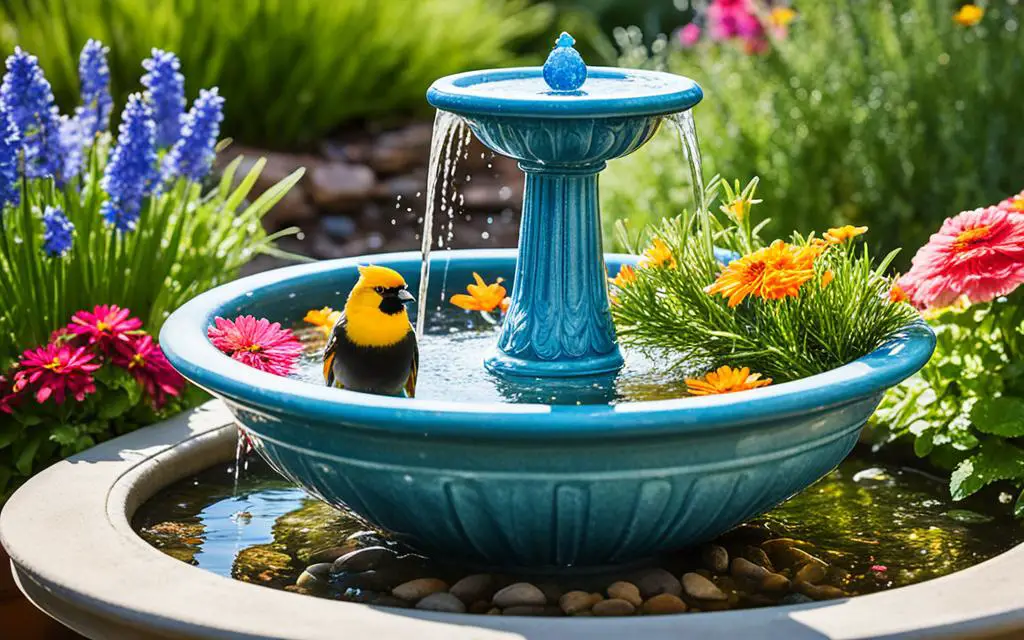
Using Heated Bird Baths in Winter
In winter, a heated bird bath is very helpful. It stops the water from freezing. This gives birds a reliable water source even when it’s cold9. Water heaters designed for bird baths are safe and keep water unfrozen without harming birds9. Using a light bulb under a flower pot works too9. Having water all winter is as important as having food. It helps birds stay healthy and survive the cold.
Ignoring Squirrel and Rodent Problems
One common mistake in backyard birding is not dealing with squirrels and rodents. These creatures can harm feeders and eat the birdseed. Fixing these issues quickly makes birdwatching better.
Protecting Your Feeders
To deal with squirrels and rodents, it’s smart to use special feeders. These feeders keep pests away10. Use feeders that are heavy, caged, or have a dome10. Stuff like cayenne pepper can also deter rodents but not harm birds10. Remember, squirrels are clever and might still get past barriers11.
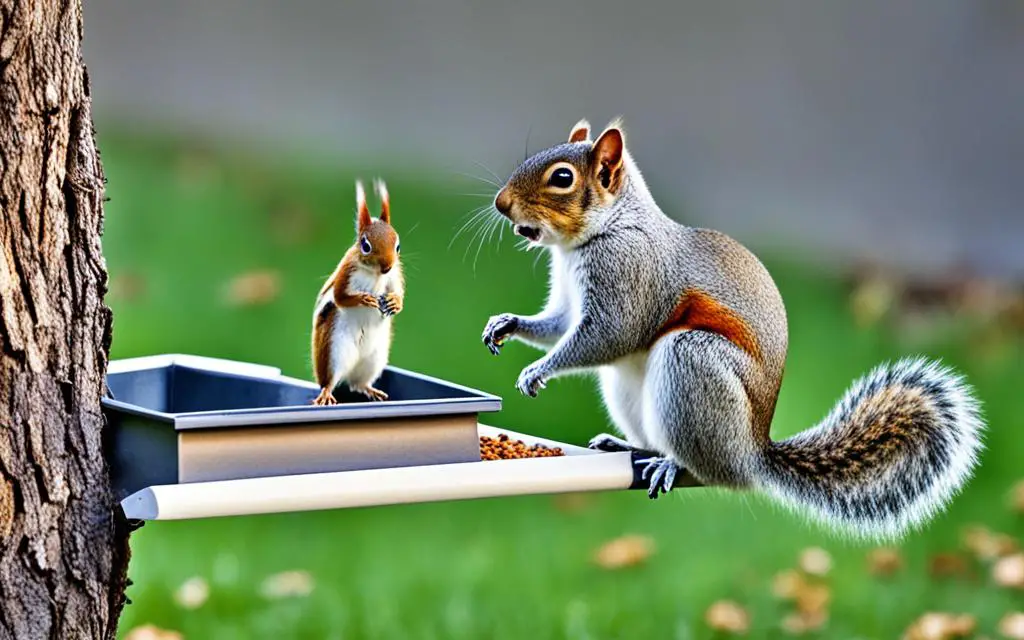
Positioning Feeders Correctly
Putting feeders in the right spot is key. Hang squirrel baffles high and away from places squirrels can jump from12. Keeping feeders away from trees and buildings limits how far squirrels can jump. This follows the 5-7-9 birding rule11. Devices like weather guards stop mice, rats, and chipmunks from getting to the feeders12. Using these methods helps with rodent problems.
Fill feeders up to two-thirds. This keeps rodents out but feeds the birds12. Regular upkeep and right positioning help protect feeders and improve birding in your yard.
Not Changing Hummingbird Nectar Frequently
Changing the hummingbird nectar often is vital for their well-being. It’s important to switch the nectar out every three to five days. This stops it from fermenting and growing bacteria that could hurt the hummingbirds4.
Making your own hummingbird nectar is usually safer than buying it. You can make a good nectar by mixing 1 part plain white sugar with 4 parts water13. Stick to using plain white sugar, as other types could harm the birds’ health13. Always let the mix cool before you fill the feeder to keep the birds safe.
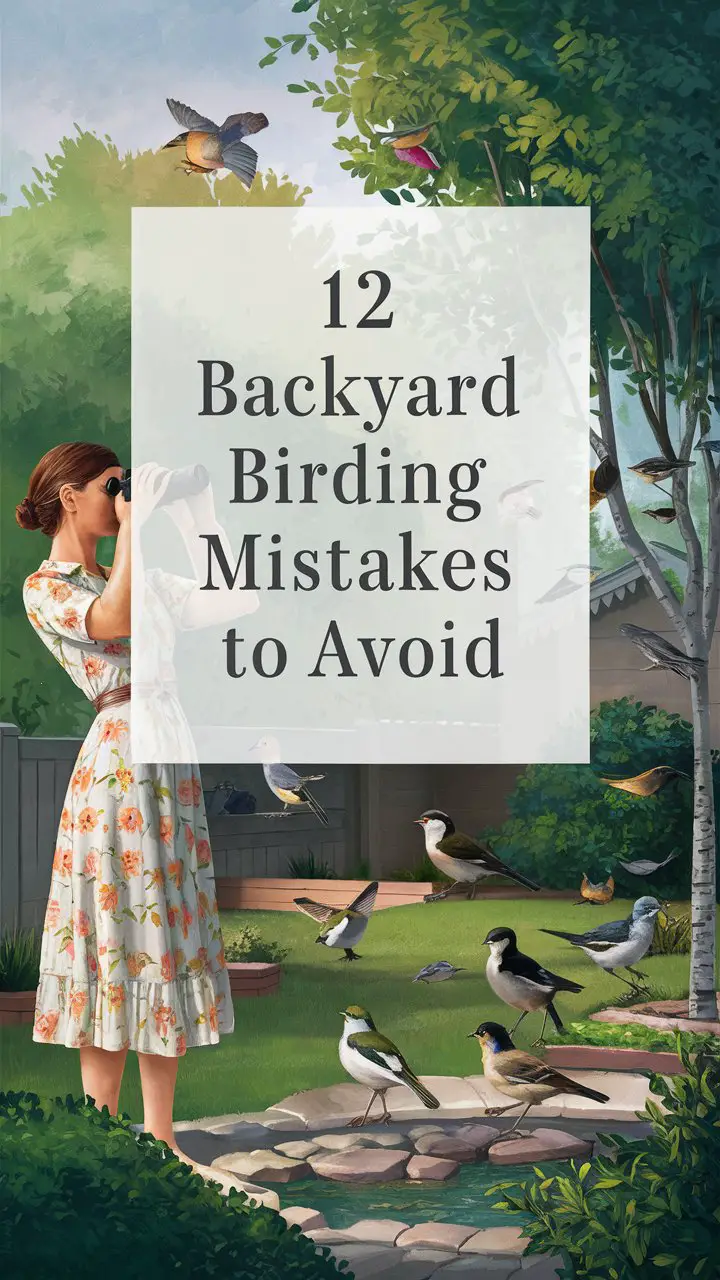
To keep hummingbirds healthy, we also need to clean feeders well. Wash them once a week with a mix of 9 parts water to 1 part bleach413. This keeps away harmful mold and bacteria, making bird watching safe and fun.
Feeders should be set up aligning with when the hummingbirds migrate. Having more feeders stops bullying over food, letting more birds enjoy the nectar13.
Providing Moldy or Stale Bird Seed
Giving birds moldy or stale seed is a mistake many make. Spoiled seeds are bad for birds. They might get sick from fungal or viral things in the seed14. Often, cheap seed mixes have grains like wheat and corn. Many birds don’t like these because they don’t offer much nutrition14.
It’s important to keep your birdseed fresh and dry. Make sure the seeds you offer are clean and not moldy. This helps keep birds healthy. Birds can’t always tell if food is bad14. So, we must be careful when feeding them to prevent sickness.
Also, picking the right food for birds is key for their health14. Opt for high-quality seeds like sunflower seeds and millet. These feeds are better and healthier for birds than mixes full of fillers15. About 70% of cheap birdseed is not eaten by birds. This creates mess and can draw pests like rats15.
To wrap up, following good bird feeding tips is important. By avoiding moldy and stale seeds, we create a better place for our bird friends.
Not Configuring Your Yard to Attract Birds
To make your yard welcoming to birds, you need more than feeders. Birds love safe places with food and shelter. They like hiding in natural spots like trees and bushes4. You can add tall evergreens for hidden nests off the ground16.
Setting Up Nesting Areas
It’s not just about trees for nesting. Try adding plants like beautyberry and Eastern red cedar. These attract birds with yummy fruits and seeds16. Have different plants for more shelter and food kinds. Birds prefer certain seeds, like goldfinches loving thistle16. Feeding spots should be a bit away from your house for birds to feel safe4.
Using Birdhouses
Birdhouses make birds want to live in your yard. Place them where they mimic natural homes. Birds need nearby trees for safety after eating seeds16. Feeders and houses should be safe from predators16. Offer foods like black oil sunflower seeds to attract songbirds164.
Source Links
- https://www.arkansasonline.com/news/2018/dec/30/dont-make-these-mistakes-when-feeding-backyard-bir/
- https://www.audubon.org/news/birdist-rule-4-avoid-making-these-boneheaded-birding-mistakes
- https://chirpforbirds.com/how-to/5-common-bird-feeding-mistakes-and-how-to-fix-them/
- https://www.kaytee.com/learn-care/wild-bird/common-backyard-birding-mistakes
- https://www.audubon.org/news/to-feed-or-not-feed
- https://www.fws.gov/story/feed-or-not-feed-wild-birds
- https://mebirdingfieldnotes.blog/2017/11/02/why-there-are-no-birds-at-your-feeders-right-now/
- https://wildwood.express/blogs/top-5-in-the-garden/top-5-bird-feeding-mistakes
- https://feederwatch.org/wp-content/uploads/2013/10/Providing-water-for-birds.pdf
- https://www.express.co.uk/life-style/garden/1895949/bird-feeder-mistake-rats-garden-fix
- https://blog.mybirdbuddy.com/post/squirrels
- https://www.perkypet.com/articles/how-to-keep-mice-and-rats-away-from-bird-feeders
- https://www.birdsandblooms.com/birding/hummingbirds-not-coming-feeders/
- https://www.perkypet.com/articles/birds-hate-these-foods
- https://toronto.wbu.com/seed-birds-bad-wrong-waste
- https://www.southernliving.com/garden/how-to-attract-birds

My name is Shane Warren, the author behind Your Bird Buddy – your ultimate guide to the wonderful world of birds! Unleash your inner avian explorer as we delve into a vibrant library of knowledge dedicated to all things feathered. From learning about diverse bird species from across the globe to understanding their captivating habitats and behaviors, I’m here to fuel your passion for these magnificent creatures. Not only that, but I also provide valuable insights on being a responsible and informed pet bird owner. Join our vibrant community and let’s celebrate the feathered wonders of the world together – one chirp at a time. And be sure to join our Your Bird Buddy Community over on Facebook!

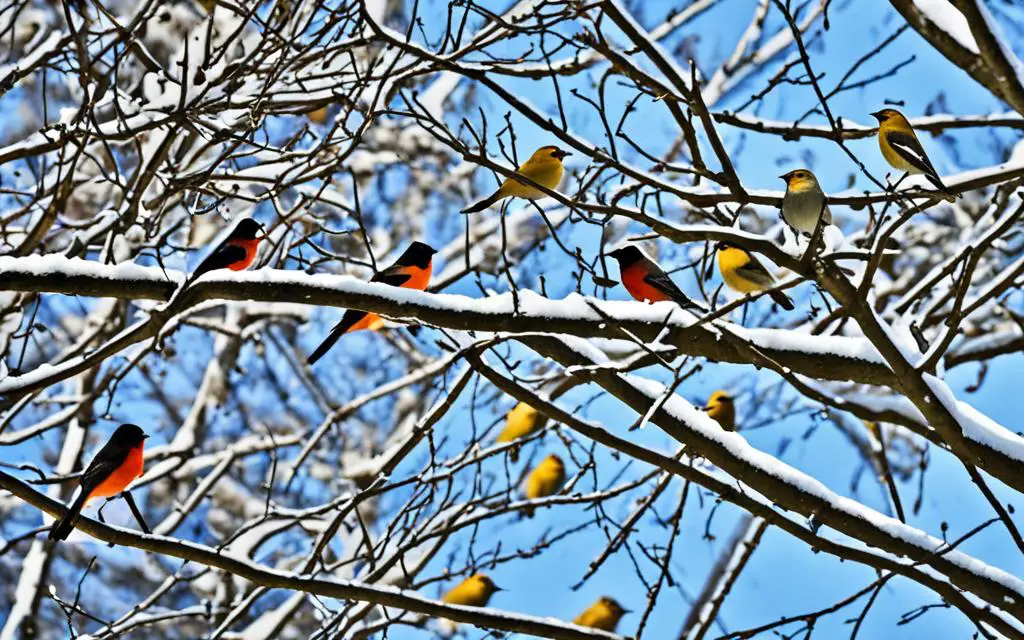
Comments are closed